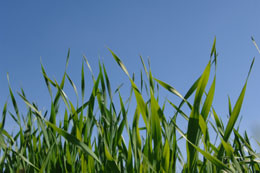Have you spotted the growth of crabgrass in your beautifully mowed lawn? This article lists ways in which you can control crabgrass.

Crabgrass invasion in your lawn makes an unpleasant sight and can be really bothersome at times. Although complete eradication of crabgrass is next to impossible, there are several ways to minimize it and prevent its future growth. Crabgrass control is something that lawn enthusiasts and landscapers are most concerned about during warmer seasons.
What is it?
Crabgrass, scientifically known as
Digitaria spp, is an annual grass weed that is commonly found in lawns and gardens. It mainly thrives in hot and dry conditions and becomes dormant or semi-dormant during the cooler months. It has wide, flat leaf blades and stems that spread low on the ground, however, they can reach up to a height of 3 feet. A type of this weed, known as smooth crabgrass, grows no more than 15 inches in height and spreads on the surface of the ground. It is considered as a serious lawn pest as it can quickly take over the entire lawn.
How to Control it?
Crabgrass is a summer annual that propagates by small seeds. A single plant can produce as many as 150,000 seeds each season. These seeds remain dormant until mid May and germinate in late spring and early summer. Full exposure to the hot summer allows the plant to grow healthy. The best way to control this weed is to destroy the seeds and stop their growth. Keeping your lawn dense and healthy is another way to prevent the invasion. Following are some ways to maintain the health of your lawn that will help to control the growth of this weed:
- Avoid fertilizing your lawn in the summer or spring, instead, do it during autumn so that it fills in and keeps the sunlight off the ground.
- Sunlight is essential for crabgrass seeds to take root. Raise the level of the lawn mower, as taller grass provides shade and keeps the sunlight away, thus keeping the seeds of crabgrass from germinating.
- Remove any patch of this weed immediately to avoid it from spreading to other areas. Pull out the weeds and destroy the seeds.
- Irrigate or water your lawn heavily once a week instead of frequent light irrigation.
- Crabgrass is allergic to healthy soils, so promote the health of your lawn to keep this weed away. Aerating it periodically by soaking the lawn helps in loosening of the soil. Dig out the roots of the weeds to remove them completely from your lawn.
- If all the above control measures fail to bring about satisfying results, you may have to use herbicides. Keep in mind that chemical herbicides are not specific to killing only crabgrass. Other plants on your lawn may be vulnerable to herbicides as well, so use it with caution. You may use pre-emergent weed killer early in the spring and repeat applications if necessary.
- Re-seed thin patches in the lawn during the late summer. Be careful if you have applied the pre-emergent weed killer as it may kill the newly seeded grass too.
Follow these simple methods to get rid of crabgrass and keep your lawn healthy.






 Crabgrass invasion in your lawn makes an unpleasant sight and can be really bothersome at times. Although complete eradication of crabgrass is next to impossible, there are several ways to minimize it and prevent its future growth. Crabgrass control is something that lawn enthusiasts and landscapers are most concerned about during warmer seasons.
Crabgrass invasion in your lawn makes an unpleasant sight and can be really bothersome at times. Although complete eradication of crabgrass is next to impossible, there are several ways to minimize it and prevent its future growth. Crabgrass control is something that lawn enthusiasts and landscapers are most concerned about during warmer seasons.